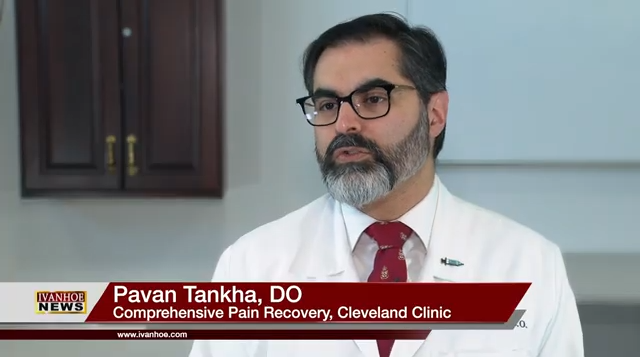Paven Tankha, MD is medical director of the Comprehensive Pain Recover Program at Cleveland Clinic talks about intravenous ketamine and chronic pain management.
Interview conducted by Ivanhoe Broadcast News in 2024.
What causes chronic pain?
Tankha: Chronic pain is a difficult entity to characterize. What we know from the last 40 years is it’s comprised of three different components. There’s a biomedical component, psychological component, and a social component, and understanding and identifying all three of these components is key in treating chronic pain. In terms of biomedical, there are different conditions, heart failure, renal failure, liver failure, diabetes, fibromyalgia, various pain states that can cause pain. In terms of psychological and this sometimes comes as a surprise to patients, depression, anxiety, post traumatic stress can also make pain worse so identifying and treating that is very important. Then finally, there’s social aspects. If you don’t know where your next meal is coming from, you don’t have a secure housing. You don’t have insurance, these can also make pain worse. By identifying and treating all of these issues, we can best understand chronic pain.
How is it traditionally treated?
Tankha: The conventional treatment of chronic pain is through the biomedical approach. So here’s a medication, here’s an injection, here’s a surgery. Oftentimes, not addressing the other components that are associated with it. Obviously, there’s a track record of these helping certain patients, but as we know, most recently, studies are showing that the transition from acute to chronic pain is increasing and so we’re having more and more patients with chronic pain. I would argue that we’re not addressing and treating it properly from the start via the biopsychosocial model.
What is ketamine normally used for?
Tankha: Ketamine was approved by the FDA in 1970 for general anesthesia and procedural sedation. About 30 years ago, we started using it as a low dose for chronic pain. More recently, it’s been approved for depression. Of label, it’s been used for anxiety, post traumatic stress as well. But again, when we look at the official label uses, general anesthesia, procedural sedation, and most recently depression.
How has ketamine treated chronic pain?
Tankha: What we found, and again, I don’t know the exact person who started this, but just a brilliant idea, let’s take this medication used at a high dose. Let’s just give it at a low dose and see what happens and so that’s what we’ve seen over the last 30 years, ketamine at very low doses, low doses, high doses, very high doses. The infusions have range dramatically from anywhere from a couple minutes to a couple hours to a couple days up to a week continuously. What we found in all that time interestingly enough is that ketamine works. We just can’t figure out who it works for inconsistently. But what we do know is at a low dose provided by someone who knows what they’re doing, it can be safe and potentially effective.
Can you explain ketamine infusion?
Tankha: I would love to. How we do it here at the Cleveland Clinic is you would come into the infusion suite. We would start an IV, and then based on your weight, we would infuse an amount of ketamine over 40 minutes. At the end of those 40 minutes, we take out the IV and we watch you for about a-half-hour to an hour to see how you’re doing. We repeat that process five days in a row. The pain relief effects of ketamine may be immediate or can take up to three to four weeks to show up. If it’s helpful, we can safely repeat it every three months as needed.
Is it FDA-approved?
Tankha: Currently ketamine is FDA-approved for general anesthesia, procedural sedation, and treatment resistant depression. Unfortunately, it’s off label uses for pain management.
How has this changed the medical field?
Tankha: There’s a lot of thought and debate. Most recently, for treatment resistant depression, ketamine has been known as a game changer. Again, for depression, which is sometimes difficult to treat. Those with treatment resistant depression are in a very difficult situation. Ketamine can work very quickly for that. For pain, again, we’ve been touting its benefits for the last 30 years, but for the life of us, we don’t know how it works, and we can’t predict who it works in. We don’t have a standardized protocol. So what we can generally agree upon is that it’s safe. It’s effective. We just have to learn more about it for chronic pain before we can use it more frequently.
Is there anything else you would like to add?
Tankha: Ultimately, the treatment of chronic pain, as I like to tell patients, pain is simply more than what you feel. It’s also what it does to you. It’s a suffering it causes. And so as physicians, we owe it to our patients to look at them as a person, simply not as a symptom and address all the things that can be causing or continuing their chronic pain via the biopsychosocial model.
Is ketamine dangerous for some patients, and if so, which ones? Is there a maximum dosage that is safe?
Tankha: The dosages of ketamine vary. We use a standard dose, which is 0.5 milligrams/kilogram, and we infuse that over 40 minutes. To put that into perspective, the anesthetic doses of ketamine are 1-2.5 milligrams/kilogram infused very quickly over a couple seconds. That can induce anesthesia. When given more slowly, very well tolerated. One thing to keep in mind though is with any ketamine infusion as the dose increases, the side effects can also potentially increase so issues with heart rate, blood pressure, hallucinations and that’s when we look at the studies that have been done thus far, there is that association. However, the lower dose, very well tolerated, side effects are similar to placebo.
How many treatments are needed and for how long each time? And then do you repeat that a year, the next year, and so on?
Tankha: There is no agreed upon protocol for ketamine, which again, sounds strange. We have this treatment for 30 years, and no one can agree how to deliver it. What we’ve decided to do here at Cleveland Clinic is we’ve come up with a standardized approach for all our patients. Again, we use that half milligram per kilogram, I used over 40 minutes times five days, and we repeat it at a three month interval. We’re still looking at the data to see how long it works for most patients. But in general, we’ve agreed upon a repeat it every three months. If it works longer, obviously, we can repeat it at a longer interval, but roughly three months. What we do know from its long term use is that a low dose it’s safe. It can be repeated three to four times a year as needed.
Does every patient respond well to it, or does it vary for every patient? Obviously, your patient Emily Ryan had great success, but are there times when things need to be adjusted for different patients?
Tankha: Yes, so that goes back to we don’t understand how ketamine works. We do have two variables we can work with the dose. We can go up on slightly. The reason we don’t go to the highest doses is we do these infusions in an outpatient setting. We don’t have resources, if again, patients have issues with heart rate or blood pressure or hallucination. We limit the dose in that sense, but that’s one thing we can do, we can increase the dose. Secondarily, we can increase the length of time of the infusion from 40 minutes to 60 minutes. We think that may possibly have an effect for some patients. But ultimately, we don’t quite have the answer and that’s the frustrating part. One of the joys of working with pain management is helping patients either decrease pain or increase their overall function, quality of life. But one of the things we think about most often are the patients we can’t help, who continue to suffer and so that’s why we’re constantly looking at different ways of figuring out one, how’s the ketamine working, and how can we deliver it more safely and effectively for those who it doesn’t help?
In Emily’s case, what were the challenges, but then, what made her a good candidate for it?
Tankha: Yeah. Because it’s not approved, ketamine is not approved by the FDA. We want to make sure patients have tried conventional medications, conservative treatments. We want to make sure evaluations for other causes of pain have been done and to be assured, there’s not something that’s being missed. In the case of Emily, we had a very good surgeon do all the evaluation, Dr. Benzel, and he said, again, surgery may not be the best option. That’s where we felt comfortable offering the ketamine. All the conventional treatments were not effective and now that’s when ketamine becomes a good option. In Emily’s case, again, she was evaluated by a very good surgeon, Dr. Benzel, and we had ensured there was nothing being missed in which case, given that she tried different treatments, ketamine becomes a good option and that’s the other thing with an off label use of a medication. You don’t want to go to it initially. You want to make sure more conventional treatments have been tried. But because ketamine is safe and potentially effective, it’s a good option for a lot of patients.
END OF INTERVIEW
This information is intended for additional research purposes only. It is not to be used as a prescription or advice from Ivanhoe Broadcast News, Inc. or any medical professional interviewed. Ivanhoe Broadcast News, Inc. assumes no responsibility for the depth or accuracy of physician statements. Procedures or medicines apply to different people and medical factors; always consult your physician on medical matters.
If you would like more information, please contact:
Halle Bishop
Sign up for a free weekly e-mail on Medical Breakthroughs called First to Know by clicking here




